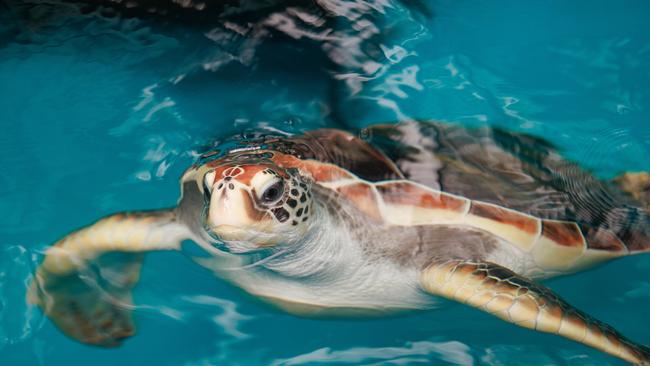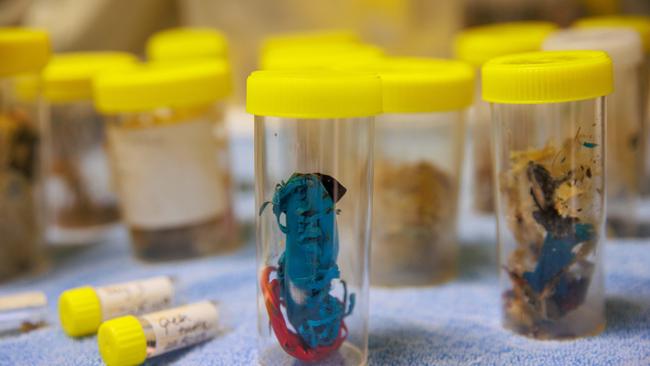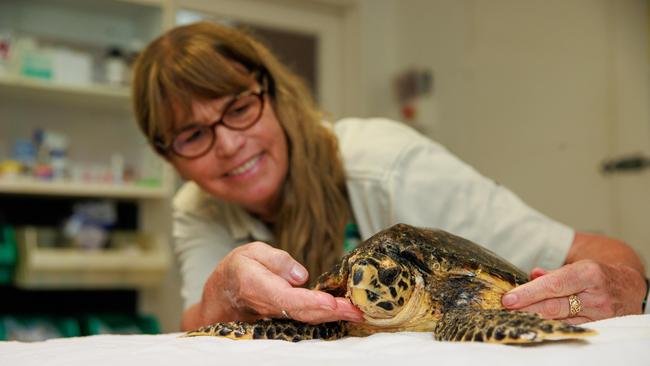Tiny turtle set for release from Taronga Wildlife Hospital after recovery from ‘tragic’ plastic consumption
Tama the hatchling turtle washed up on a Sydney beach having eaten so much plastic her gut was riddled with it. It should have killed her. But 18 months on, she’s set for release.
NSW
Don't miss out on the headlines from NSW. Followed categories will be added to My News.
Tama the turtle has delighted staff at Taronga Wildlife Hospital with her incredible recovery journey since washing up on Tamarama beach with plastic in her gut.
The green sea turtle was found by a beachgoer as a very small hatchling 18 months ago, Taronga Wildlife Hospital’s Rescue and Rehabilitation Coordinator Libby Hall said.
Despite being small enough to fit inside the palm of a hand when she was first brought in, Tama was had a big appetite for the wrong food: she was plagued by plastic consumption.
“The really tragic thing was even at that age, she was pooing plastic,” Ms Hall said.
“So we were finding small pieces of plastic in the pool, even at the very, very young hatchling age,” Ms Hall said.

The condition is often deadly for turtles, however Tama is finally set for release after an 18-month recovery.
“Survivability increases with age and size … So we’re really wanting to give her as much a chance as possible — she’ll be released quite soon,” Ms Hall said.
Unfortunately, Tama isn’t the only turtle being plagued with plastic in the gut, as plastic pollution, fishing line and hook entanglement are major threats to marine species.
In addition, six kinds of marine turtles call Australian waterways home, and all of them are endangered, sparking the need for immediate action.

In a bid to help protect turtles’ habitats, Taronga Wildlife Zoo has paired with Veolia to track turtles released into the wild via satellite, which allows them to see what habitats and environments the turtles are drawn to, Ms Hall said.
“This is so important if we’re going to save these animals, we need to protect their environments,” she added.
The results have been surprising, with juvenile turtles frequenting busy ports around NSW: areas they “didn’t ever think they would go”, according to Ms Hall.
“No wonder they’re getting entangled in fishing line and hooks. Especially in summer months, they’re all up there with all the boating people,” Ms Hall said.
“These animals are trying to survive in an urban environment with all the humans at play, it’s very difficult for them.”
Veolia ANZ CEO Richard Kirkman added that it’s “extraordinary” turtles remain so close to us, however it comes with a “responsibility to protect these creatures”, urging Australians to think twice before purchasing plastic items that could cause turtles harm.

Summer is peak season for turtle rescues and data reveals turtles often swim nearby busy areas, so beachgoers are likely to come across a turtle in need this summer.
“If you find a turtle washed up on the beach then it really does need help,” Ms Hall said, urging people to bring injured turtles to the wildlife hospital as quickly as possible.
“The sooner you we get the animals, the more change we have of saving those animals,” she said.
Carefully picking up the turtle and putting them in a plastic tub with a towel at the bottom — and covering the top — is the best way to transport injured or sick turtles.




